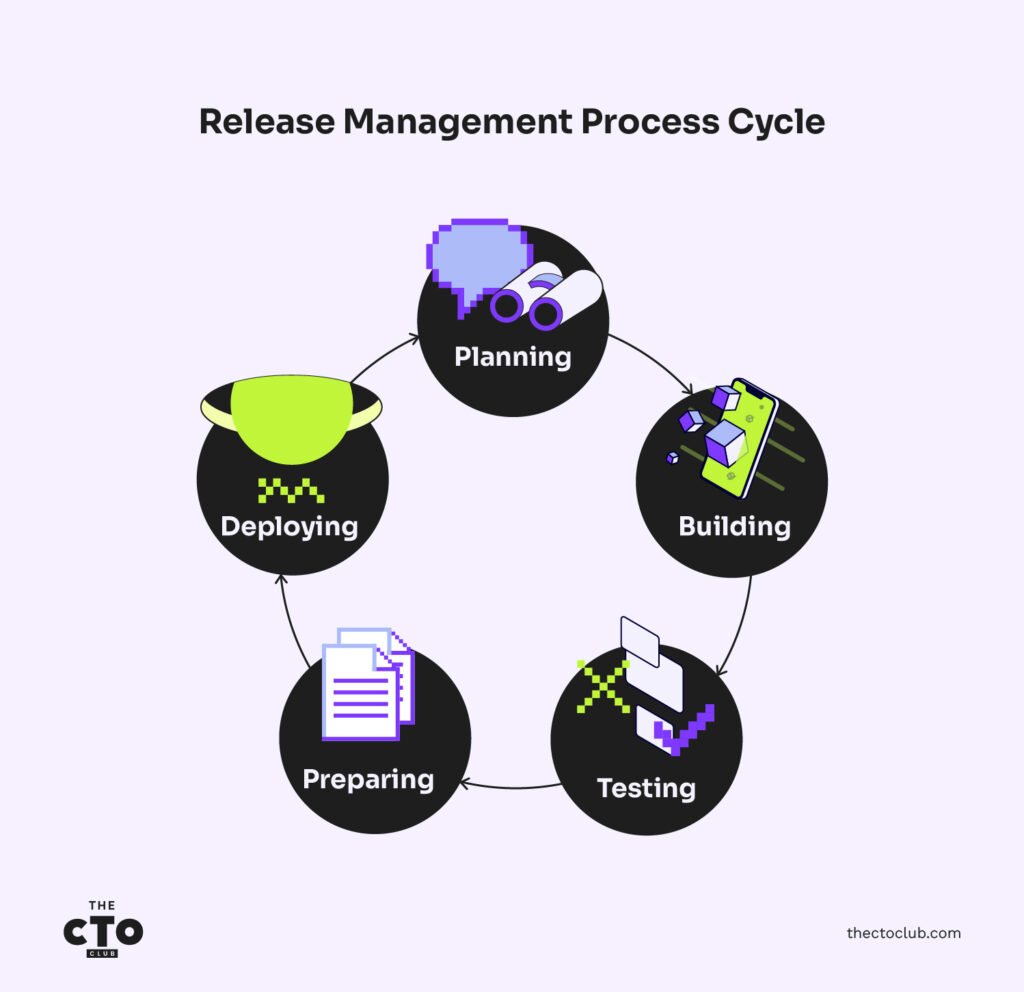Release management is a critical facet of the software development lifecycle that oversees planning, scheduling, and controlling the movement of releases through different stages. The main focus is on the build, test, deployment, and delivery of software. It's necessitated by the scale, complexity, and frequent modifications of software products, and helps mitigate risks associated with these factors.
Under the ambit of ITIL, release management coalesces the technical and non-technical aspects of software development to ensure the timely and efficient delivery of high-quality software releases. Leveraging release orchestration tools can significantly streamline these processes, enabling organizations to achieve faster time-to-market and improve overall release efficiency.
What is Release Management?
Release management in software development refers to building, releasing, and deploying software to the end users. This covers every process step, from planning and development to testing, the software deployment process, and software delivery. Production teams can now handle the sometimes difficult delivery lifecycle using release management. A good release management system should also provide the best possible user experience and align with the broader company's aims.
The objective is to ensure fast, reliable, and efficient delivery of new features, enhancements, fixes, and updates to end users. Release management plays an important role in DevOps by reducing the possibility of mistakes and downtime while ensuring that software is delivered in a timely and dependable way.is delivered.
Why is Release Management Important?
Some of the most important benefits of having a proper release management framework in place are:
- Fewer errors and defects: First and foremost, a good release management process contributes to the organization's ability to generate a high-quality and dependable product. Software release involves several processes, including development, testing, and deployment, and there are numerous potential for mistakes along the path. Having a good release management procedure in place is an essential component of quality assurance.
- Increased efficiency: An effective release management approach will improve your organization's efficiency and help prevent releases from disrupting the development team’s productivity. With appropriate release management, the release cycle becomes less of a disruption and more of a constant component of the development process.
Better user experience: More frequent releases will keep the customers happy by providing fast fixes and new software features more often.

1. Planning
The entire process is structured in the planning stage. A good release plan checks that standards and requirements are met. The SDLC (software development life cycle) approach helps the development team plan, develop, maintain, and efficiently replace software systems.
During the planning stage, create a workflow that contains the release schedule and involves team members and stakeholders. The release plan should include timelines, delivery dates, requirements, and the project scope. A release management checklist or workflow tool can clarify the process. Once the plan is complete, it should be presented to the stakeholders for review before implementation.
2. Build
Once the release plan is done, the build phase can start. This is the phase where the actual development work is performed.
In the build stage, the team designs and builds the software based on the available requirements. Once a working version is ready, real-world scenario testing can be started. If any bugs or issues are found, the build is returned for further development until the release is approved.
3. Testing
The testing phase in release management refers to UAT or user-acceptance testing. This is where real users test the application and provide feedback. This is usually done through beta testing, where a free version is given to a selected set of users, or by having the QA team perform testing that validates the acceptance criteria.
The importance of the testing phase lies in the amount of data collected and the fixes made so that the build is stable and ready for release.
The process is iterative. When new defects are found, the team fixes the issues and redesigns the build for better stability. The build should pass the testing stage to be considered for final implementation and release.
4. Deployment
At this stage, the code is released to the live environment, making it available to all users. However, there are some more components to follow. Users should be informed about the changes and additional functionality in the new build and, if necessary, provided with training to understand the release. These steps ensure the best return on investment.
5. Review
The last phase in release management is the post-release review stage. How did the release process go? What areas need to be addressed for future development and deployment effectiveness? Every software development life cycle should aim to identify opportunities for continuous improvement within your team.
After the new version is delivered, users will undoubtedly discover issues, provide comments, and make new requests to the creators. To guarantee client satisfaction, processes for dealing with errors must be implemented.
5 Release Management Best Practices
1. Define your criteria
How do you decide that the software product is ready for delivery? Clear requirements in release activities and testing lead to more stable deliveries. A successful release has to be based on well-defined criteria. This way, you can learn from past mistakes and iterate on the release management process to find the most effective one for your team.
Before proceeding with the project, key release metrics, KPIs, and acceptance criteria need to be agreed upon.
2. Mimic the production environment
During staging and testing, aim to build an environment as similar to real-world production conditions as possible. If you're making updates, try creating new ones instead of changing the existing ones. This can lower the probability of errors or mistakes in releases, resulting in more dependable products that meet user, company, and customer expectations.
3. Automate your processes
Many processes can benefit from automation, starting from testing to deployment. This can speed up the entire release management process. Whether in development, quality assurance, or IT operations, automation should reduce the chances of human error, create shorter feedback loops, and make day-to-day operations easier for all employees. By allowing the team to spend more time on strategic thinking and less time on repetitive tasks, you can provide reliable products to your clients.
4. Track the right metrics
When setting your requirements and criteria, think about providing measurable metrics that will allow you to track your progress and make sure you're meeting your objectives. Metrics such as downloads, defect rate, load times, conversions, and outages help you measure your progress and align the development team with the business goals.
Other important metrics can be team velocity and burnout rate. Many project management tools, like Jira, can be easily set up to provide these metrics.
5. Limit the impact on users
Prioritizing testing and defining accurate criteria will help minimize user impact and ensure smooth release rollouts. Work to provide new releases efficiently and rapidly so users can have an error-free experience.
Dark launches and other proactive testing procedures can reduce deployment hazards. Real-time warnings and continuous monitoring can help you detect, minimize, and address issues throughout your release.
Implement Adaptive Release Management Strategies
Effective release management requires flexibility and customization based on your organizational context. Rather than following a rigid, one-size-fits-all approach, successful teams adapt their release practices to specific project needs and team capabilities.
Key decision points in adaptive release management:
- Release cadence: Determine whether continuous delivery, time-boxed releases, or feature-based releases best suit your product and market needs
- Deployment approach: Select from strategies like blue-green deployments, canary releases, or phased rollouts based on your risk tolerance and infrastructure
- Testing intensity: Adjust testing depth and coverage based on the criticality of features and potential impact on users
- Stakeholder involvement: Scale communication and approval processes appropriately for each release type
The most successful release management practices incorporate disciplined flexibility. For instance, mission-critical applications might require more rigorous testing and approval processes, while internal tools might benefit from faster, more streamlined release cycles.
You can create a scalable framework that evolves with your organization by evaluating each decision point in your release management process and selecting techniques that align with your specific context. This adaptive approach helps balance speed and quality while reducing release-related stress across your development teams.
Pro tip: Document each technique's advantages and disadvantages in your release management workflow. This creates institutional knowledge that helps teams make consistent decisions aligned with strategic priorities.
Join for More Insights
Our release management systems must grow at the same rate as people learn and technology evolves. Continuous improvement of people, processes, and technology is critical for any successful DevOps release management framework.
Boost your SaaS growth and leadership skills. Subscribe to our newsletter for the latest insights. We'll help you scale smarter and lead stronger with guides, resources, and strategies from top experts!







